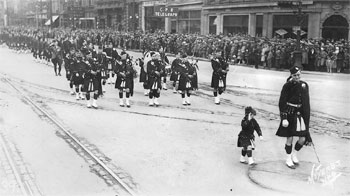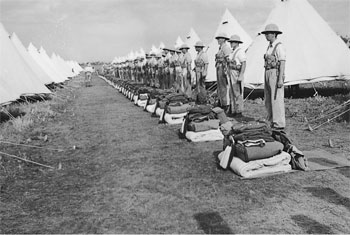 |
|
Kit Shop | Downloads | Links | Site Map | Contact Us |
|
The Inter-war Years 1919-1938Post-war ReorganizationWith the return of peace, returned men from the various Cameron Overseas Battalions were encouraged to re-enlist with the old regiment. However, after four years of war many of them had had enough of the army, its hardship, danger and discipline. Recruiting moreover, was not the only problem. Funding for the military was drastically reduced as Canada returned to a peacetime economy. Training was restricted and no new equipment was forthcoming. The financial situation of the Regiment, occasionally required men to sign over their pay... �to supplement the funds and assist towards running expenses, all ranks have voluntarily assigned their pay, and thus helped offset the rather meager financial assistance furnished from the �seat of power...� Despite these obstacles the Regiment maintained an average enrollment of over two hundred. Morale was high, and a fierce regimental pride motivated its members. The Regiment did not forget its returned veterans. Its �Cameron Club� catered to their social welfare. Facilities included spacious lounge rooms, reading, writing and billiard rooms and a refreshment bar. In May and June 1919 Winnipeg found itself sharply and violently divided between opposing factions of a general strike. To cope with these civic crises detachments of police and the military were moved into the city. Militia volunteers, including the Camerons, were called into action. 
A reorganization of the Canadian militia took place in 1920. The numerical designation �79th� was dropped from the Regimental title making it simply, the Cameron Highlanders of Canada. The Regiment was reorganized as three battalions: the 1st Battalion �43rd Battalion CEF�, 2nd (Reserve) Battalion (174th Battalion CEF) and 3rd (Reserve) Battalion (179th Battalion CEF). The 1st Battalion was, in effect, the only active militia unit. The 2nd and 3rd Battalions were reserve units where non-active personnel could transfer for an interim period or upon retirement and remain subject to future recall.
The Scottish National War Memorial was inaugurated on 14 July 1927. The Role of Honour of the Queen�s Own Cameron Highlanders of Canada containing the names of 49 officers and 1180 other ranks killed on active service in the Great War, was deposited there. The following First Presbyterian Church replaced St. Stephen�s as the spiritual home of the Regiment. The Colours of the 79th Regiment, 43rd Battalion, and the Winnipeg Highland Cadets are deposited there. On 3 October 1929 the Great War Battle Honours of the Regiment were gazetted and arrangement to emblazon them on the Regimental Colour were made. Depression YearsThe Regiment celebrated its 25th anniversary in 1935. The three day celebration (4-6 May) was attended by more than 700 Camerons..."An orchestra dispensed lively music throughout the evening, but there was no program; it was useless to attempt one.; every one wanted to talk to every other body. Men who had not met for years exchanged greetings, and many old friendships were renewed, and a good time was had by all." -79th News The Depression years brought a different challenge to the Regiment. Many Camerons found themselves without civilian employment due to generally poor economic conditions. Activities such as musketry, picnics and parties involving and entertaining the families of unit members helped maintain a high level of esprit-de-corps. Training
The Regiment held its own camp at Matlock, on Lake Winnipeg, in 1933. The daily routine began at 6 a.m. At 6:15 there was cocoa, then bathing parade followed by breakfast of traditional oatmeal porridge. For the remainder of the day-training and sports. In 1936 official summer camps resumed at Camp Shilo and continued annually until the beginning of the Second World War. Athletic and sports were an important part of training. It is recorded that a regimental snowshoe race was organized in the winter of 1937/38 and run over a course from Churchill to Winnipeg. The winner finished in record time, although he had to contend with slush ice while crossing the Nelson River, and the odd pot-shot from Indians who mistook him for a buffalo. The life of a Militia Highland Regiment was not complete without its Hogmanays, Burns Suppers, Ceilidhs, and the Annual Christmas Tree Party given for the orphans of veterans and the children of serving members. The Queen's Own Cameron Highlanders of Canada was not only an organization for military training, but also a centre for social recreation involving all members of this extended group of Kith and Kin... The Second World War 1939-1945 |
| © 2006 - The Queen's Own Cameron Highlanders of Canada |

 In 1923 the Regiment formed an alliance with the Cameron Highlanders of Ottawa (38th Battalion CEF). The following year on 24 October, his Majesty King George V was �graciously pleased� to grant permission for the Regiment to be named the Queen�s Own Cameron Highlanders of Canada.
In 1923 the Regiment formed an alliance with the Cameron Highlanders of Ottawa (38th Battalion CEF). The following year on 24 October, his Majesty King George V was �graciously pleased� to grant permission for the Regiment to be named the Queen�s Own Cameron Highlanders of Canada.  .Training remained the top priority. Provisional and Royal Schools of Instruction provided courses on various aspects of infantry training. They were conducted by Permanent Force members of the School of Infantry at Fort Osborne Barracks. Although some courses were open to all ranks, the emphasis was on producing a knowledgeable and experienced cadre of officers and senior non-commissioned officers. In addition to regular training nights, The regiment was authorized to run Regimental Courses of Instruction to provide infantry qualifications for the men. Annual summer camps also provided valuable training and the opportunity to gain practical experience in tactics. Summer camps were suspended for the first few years following the war. However, in 1925 a camp was held in Winnipeg and from 1926 to 1928 the Camerons trained at Camp Hughes (formerly Camp Sewell).
.Training remained the top priority. Provisional and Royal Schools of Instruction provided courses on various aspects of infantry training. They were conducted by Permanent Force members of the School of Infantry at Fort Osborne Barracks. Although some courses were open to all ranks, the emphasis was on producing a knowledgeable and experienced cadre of officers and senior non-commissioned officers. In addition to regular training nights, The regiment was authorized to run Regimental Courses of Instruction to provide infantry qualifications for the men. Annual summer camps also provided valuable training and the opportunity to gain practical experience in tactics. Summer camps were suspended for the first few years following the war. However, in 1925 a camp was held in Winnipeg and from 1926 to 1928 the Camerons trained at Camp Hughes (formerly Camp Sewell).